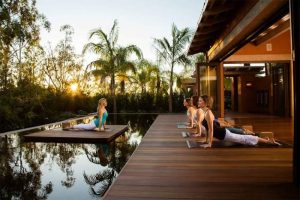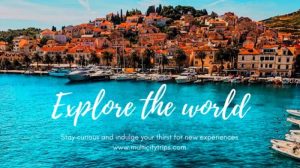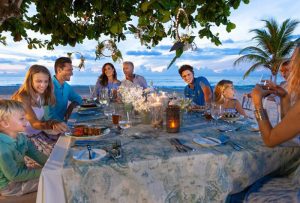
Mastering the art of travel photography hinges on understanding your camera’s capabilities. This guide delves into the essential camera settings that will elevate your travel images from snapshots to professional-quality photographs, transforming your memories into stunning visual narratives. We’ll explore aperture, shutter speed, ISO, and composition techniques, empowering you to capture breathtaking landscapes, vibrant cityscapes, and evocative portraits, no matter the lighting conditions.
From mastering depth of field to understanding the nuances of light and exposure, we’ll equip you with the knowledge to confidently capture captivating images. We’ll also discuss post-processing techniques to enhance your photos and create a consistent editing style. This comprehensive guide aims to bridge the gap between technical knowledge and creative vision, enabling you to capture the essence of your travels with unparalleled clarity and artistry.
Camera Settings for Sharp Images
Achieving sharp, crisp images is paramount in travel photography, allowing you to capture the vibrancy and detail of your experiences. Mastering aperture, shutter speed, and ISO settings is key to this goal. Understanding how these settings interact will significantly improve your photography.
Aperture and Depth of Field
Aperture, controlled by the f-stop number (e.g., f/2.8, f/8), dictates the size of the lens opening and directly influences depth of field – the area of the image that appears in sharp focus. A wide aperture (low f-number like f/2.8) creates a shallow depth of field, ideal for isolating subjects like portraits against a blurred background. Conversely, a narrow aperture (high f-number like f/16) yields a large depth of field, perfect for landscapes where you want everything from foreground to background in sharp focus.
For travel portraits, f/2.8 to f/5.6 often work well, while landscapes frequently benefit from f/8 to f/16 or even smaller apertures, depending on the scene and desired effect. Remember that extremely narrow apertures can lead to diffraction, reducing sharpness.
Shutter Speed and Motion Blur
Shutter speed, measured in seconds or fractions of a second (e.g., 1/200s, 1s), determines how long the camera’s sensor is exposed to light. Faster shutter speeds (e.g., 1/500s or faster) freeze motion, preventing blur in images of moving subjects like people or vehicles. Slower shutter speeds (e.g., 1/30s or slower) can create motion blur, which can be a stylistic choice, particularly for conveying movement in scenes like waterfalls or city streets at night.
In low-light situations, a slower shutter speed might be necessary, but a tripod is crucial to avoid camera shake blur. For sharp images of moving subjects, a shutter speed of at least 1/250th of a second is generally recommended. For stationary subjects in low light, a tripod and a slower shutter speed combined with a higher ISO might be needed.
ISO and Image Noise
ISO measures the sensitivity of your camera’s sensor to light. A lower ISO (e.g., ISO 100) results in cleaner images with less noise (grain), but requires more light. Higher ISO settings (e.g., ISO 3200 and above) allow shooting in low light, but introduce more noise, which can detract from image quality. Finding the right balance is crucial.
| Light Level | ISO Setting | Image Noise | Image Quality Notes |
|---|---|---|---|
| Bright Sunlight | ISO 100-200 | Minimal | Excellent detail and clarity |
| Overcast Day | ISO 200-400 | Low | Good detail and clarity |
| Twilight/Indoor Lighting | ISO 800-1600 | Moderate | Acceptable detail, some noise visible |
| Very Low Light | ISO 3200 and above | High | Detail may be compromised, significant noise |
Lighting and Exposure

Mastering light and exposure is paramount in travel photography. The quality and direction of light dramatically impact the mood, atmosphere, and overall impact of your images. Understanding how to harness light, regardless of the conditions, will elevate your photography significantly. This section will delve into strategies for managing light and achieving consistently well-exposed photographs.
Light Direction and Quality
Light direction and quality profoundly affect the look and feel of your photographs. The “golden hour,” the period shortly after sunrise and before sunset, offers soft, warm light that’s incredibly flattering for landscapes and portraits. This soft light minimizes harsh shadows, creating a more even and pleasing illumination. In contrast, harsh midday sun casts strong shadows, potentially leading to overexposed highlights and underexposed shadows.
Shooting during midday requires careful consideration of your subject placement and potential use of fill flash or reflectors to balance the light. Overcast days, while lacking the vibrant colors of golden hour, provide a soft, diffused light ideal for detailed shots and minimizing harsh contrasts. Learning to recognize and adapt to these varying light conditions is key to consistently capturing stunning travel photos.
Exposure Compensation
Exposure compensation allows you to fine-tune your camera’s metering to achieve the desired brightness. This is particularly useful in tricky lighting scenarios. For example, backlit subjects often appear underexposed because the camera meters the bright background, not the darker subject. In such cases, positive exposure compensation (+1 to +2 stops) brightens the image, correctly exposing the subject.
Conversely, high-contrast scenes, with both very bright and very dark areas, might benefit from slight negative exposure compensation (-1/3 to -1 stop) to prevent overexposure in the highlights. Experimentation and practice are crucial to mastering exposure compensation; learn to “see” the light and anticipate how your camera will meter it. For instance, a snowy landscape might need negative exposure compensation to avoid overexposure, while a dark forest scene might need positive compensation to lift the shadows.
Metering Modes
Understanding your camera’s metering modes is essential for accurate exposure. Different metering modes average light differently across the scene.
- Evaluative (or Matrix) Metering: This mode analyzes the entire scene to determine the average exposure. It’s a versatile option that works well in most situations, automatically adjusting for varying light conditions. It’s a good starting point for beginners.
- Spot Metering: This mode measures the light in a very small area (typically a circle in the center of your viewfinder). This is ideal for situations where you want to accurately expose a specific detail, such as a brightly lit flower against a dark background. You can carefully place this spot on the crucial area you want to expose properly.
- Center-Weighted Metering: This mode gives the most weight to the light in the center of the frame, but still considers the surrounding areas. It’s a good compromise between evaluative and spot metering, offering a balance of overall scene assessment and prioritized center exposure. This mode is useful when your subject is located in the center of your frame but the background is significantly different in brightness.
Post-Processing Workflow

Post-processing is a crucial step in travel photography, allowing you to refine your images and achieve a consistent, professional look. It’s where you can elevate your snapshots into captivating visuals that truly represent your experiences. This process involves a series of adjustments to enhance various aspects of your photographs, from subtle tweaks to more significant transformations.Effective post-processing involves a structured workflow to ensure efficiency and consistency.
This workflow typically begins with importing your images and progresses through various adjustments, culminating in export and archiving. A well-defined workflow minimizes time spent on individual images and maximizes the overall quality of your portfolio.
Exposure, Contrast, and Color Adjustments
Adjusting exposure, contrast, and color forms the foundation of most post-processing workflows. Exposure correction addresses brightness levels, ensuring your images aren’t too dark or too bright. Contrast adjustments enhance the difference between light and dark areas, creating depth and visual interest. Color correction involves fine-tuning the color balance, saturation, and vibrancy to achieve accurate and appealing colors.
Many software programs offer tools like levels, curves, and white balance adjustments to precisely control these aspects. For example, using the curves tool in Adobe Lightroom, one can selectively brighten shadows or darken highlights to achieve a more dramatic look, while adjusting the white balance can correct color casts caused by different lighting conditions.
Sharpening, Noise Reduction, and Color Correction Techniques
Sharpening techniques enhance the details and definition within your images, making them appear crisper and more defined. This is particularly useful for images that may appear slightly soft due to camera settings or motion blur. Noise reduction tools minimize the appearance of grain or digital noise, particularly prevalent in low-light photography. This preserves image detail while improving clarity.
Color correction goes beyond simple white balance adjustments; it involves addressing individual color channels to refine hues, saturation, and overall color harmony. Software like Adobe Photoshop provides advanced tools like the Unsharp Mask filter for sharpening, while Lightroom offers effective noise reduction algorithms. Specific techniques include using selective sharpening on key areas, such as faces or landscapes, and employing noise reduction selectively to avoid over-processing.
Creating a Consistent Editing Style
Maintaining a consistent editing style across your travel photos is key to creating a cohesive and professional portfolio. This involves establishing a set of preferences for exposure, contrast, color grading, and sharpening. Begin by defining your desired aesthetic—whether it’s a bright and airy look, a moody and dramatic feel, or something in between. This style guide will serve as a reference point when editing individual images.
Develop presets or custom settings within your editing software to streamline the process and ensure uniformity. For example, you might create a preset for landscape photos that slightly increases saturation and applies a subtle vignette, while another preset is used for portraits to enhance skin tones and reduce blemishes. Regularly review your edited photos to ensure consistency and make adjustments to your style guide as needed.
Travel Hacks & Tips (Related Topics)
Efficient and comfortable travel is crucial for maximizing your photography opportunities and overall enjoyment. Careful planning and the application of a few smart strategies can significantly enhance your travel experience. This section will explore various travel hacks, insurance options, essential tips for photographers, visa information, and the broader context of the travel industry.
Travel Hacks for Efficiency and Comfort
Effective travel planning involves more than just booking flights and accommodation. These time-saving and comfort-enhancing tips can make a significant difference to your overall trip.
- Pack light: Utilize packing cubes to compress clothing and maximize space in your luggage. Choose versatile clothing items that can be mixed and matched. Avoid overpacking; you can always do laundry along the way.
- Utilize technology: Download offline maps and translation apps before your trip. Use flight tracking apps to monitor your flights in real-time. Consider a portable charger for your devices.
- Learn basic phrases in the local language: Even a few basic greetings can go a long way in enhancing your interactions with locals.
- Book accommodations strategically: Consider location relative to your planned activities. Look for accommodations with good reviews and amenities that suit your needs.
- Take advantage of public transportation: Explore local buses, trains, or subways as cost-effective and often scenic alternatives to taxis.
Travel Insurance Coverage Options
Travel insurance is a crucial aspect of responsible travel, providing financial protection against unforeseen circumstances. Various types of coverage are available to cater to different needs and budgets.Comprehensive travel insurance typically includes coverage for medical emergencies, trip cancellations, lost luggage, and flight delays. Specific policies may offer additional coverage for activities like adventure sports or specific medical conditions.
It’s essential to carefully review the policy details and ensure the coverage aligns with your travel plans and personal circumstances.
Essential Travel Tips for Photographers
Protecting your valuable photography equipment and efficiently managing your gear is paramount for successful travel photography.
- Pack a dedicated camera bag: Invest in a high-quality, well-padded camera bag that offers adequate protection against impacts and weather conditions.
- Carry essential gear separately: Keep your camera body and lenses in a carry-on bag to avoid checked baggage handling risks.
- Back up your photos regularly: Utilize cloud storage or multiple external hard drives to safeguard your precious images against data loss.
- Protect your gear from the elements: Use rain covers and lens hoods to protect your equipment from rain, dust, and other environmental factors.
- Learn about customs regulations: Understand any restrictions or requirements for importing or exporting photography equipment to your destination.
Obtaining Travel Visas and Necessary Documentation
Securing the necessary travel documents is a critical step in the travel planning process. Visa requirements vary significantly depending on your nationality and your destination country. It’s crucial to check the specific visa requirements well in advance of your trip, often several weeks or even months before departure, to allow sufficient processing time. Necessary documentation may also include copies of your passport, travel insurance policy, flight and accommodation confirmations, and any other relevant permits or licenses.
Popular Urban Escapes and Photographic Opportunities
Many cities worldwide offer exceptional photographic opportunities. Examples include:
- Kyoto, Japan: Known for its traditional architecture, serene gardens, and vibrant street life.
- Paris, France: Iconic landmarks, charming streets, and artistic flair provide endless photographic inspiration.
- New York City, USA: A dynamic metropolis with a diverse range of architectural styles, cultural experiences, and bustling street scenes.
- Buenos Aires, Argentina: A city with a rich European heritage, vibrant tango culture, and colorful architecture.
Vacation Packages and Programs
The travel industry offers a wide range of vacation packages and programs catering to various preferences and budgets. These may include all-inclusive resorts, guided tours, adventure travel packages, and customized itineraries. Choosing a package that aligns with your interests and travel style can simplify the planning process and often offer cost savings.
Venture Capital in the Travel Industry
Venture capital plays a significant role in the growth and innovation of the travel industry. Investments in travel technology startups, sustainable tourism initiatives, and innovative travel platforms are driving change and shaping the future of travel. Examples include investments in companies developing advanced booking platforms, personalized travel experiences, and sustainable travel solutions. Venture capital funding helps these companies scale their operations, expand their reach, and ultimately enhance the travel experience for consumers.
By understanding and mastering the camera settings discussed, you can significantly improve the quality of your travel photography. Remember that practice is key – experiment with different settings in various situations to find what works best for you. With a keen eye for composition, a grasp of lighting, and the technical skills to capture sharp, well-exposed images, your travel photographs will become compelling visual stories that capture the essence of your adventures for years to come.
Embrace the journey, experiment, and let your creativity shine through your lens.
FAQ Section
What type of camera is best for travel photography?
Mirrorless cameras are generally preferred for their lightweight and compact design, but a good quality DSLR can also work well. The best camera is the one you are comfortable using.
How important is a tripod for travel photography?
A tripod is highly recommended, especially for low-light situations or when using longer shutter speeds to prevent camera shake and ensure sharp images.
What are some essential accessories for travel photography?
Consider extra batteries, memory cards, a lens cleaning kit, and a portable charger. A polarizing filter can also greatly enhance your images.
How do I deal with harsh midday sun in my travel photos?
Seek shade, shoot during the golden hour (sunrise/sunset), or use fill flash to balance the light. Experiment with backlighting for dramatic effects.





